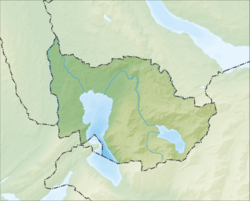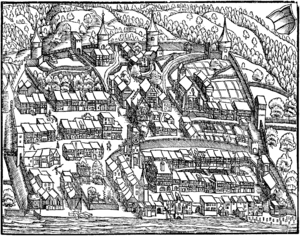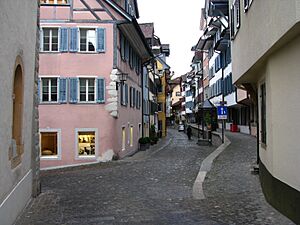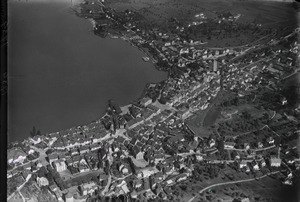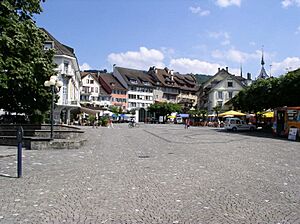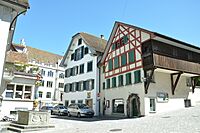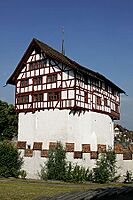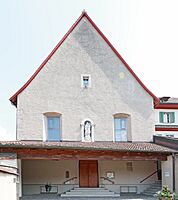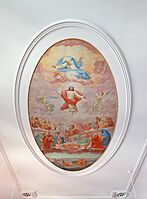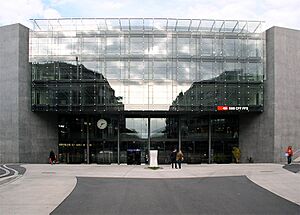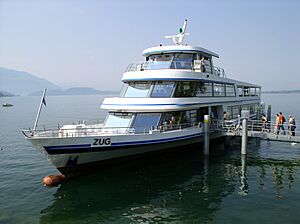Zug facts for kids
Quick facts for kids
Zug
|
|||
|---|---|---|---|
|
Municipality
|
|||
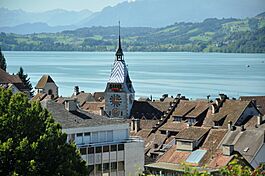
View over Lake Zug with the old town of Zug and the Zytturm
|
|||
|
|||
| Country | Switzerland | ||
| Canton | Zug | ||
| District | n.a. | ||
| Area
Lua error in Module:Wd at line 1575: attempt to index field 'wikibase' (a nil value).
|
|||
| • Total | Lua error in Module:Wd at line 1,575: attempt to index field 'wikibase' (a nil value). km2 (Formatting error: invalid input when rounding sq mi) | ||
| Elevation
(Landsgemeindeplatz)
|
425 m (1,394 ft) | ||
| Highest elevation
(Zugerberg)
|
1,039 m (3,409 ft) | ||
| Lowest elevation
(Sumpf (Dorfbach))
|
415 m (1,362 ft) | ||
| Population
(2018-12-31)Lua error in Module:Wd at line 1575: attempt to index field 'wikibase' (a nil value).
|
|||
| • Total | Lua error in Module:Wd at line 1,575: attempt to index field 'wikibase' (a nil value). | ||
| Demonym(s) | German: Zuger/Zugerin | ||
| Time zone | UTC+01:00 (Central European Time) | ||
| • Summer (DST) | UTC+02:00 (Central European Summer Time) | ||
| Postal code(s) |
6300
|
||
| SFOS number | Lua error in Module:Wd at line 1575: attempt to index field 'wikibase' (a nil value). | ||
| Surrounded by | Cham, Baar, Walchwil, Steinhausen, Unterägeri | ||
| Twin towns | Fürstenfeld (Austria), Kalesija (Bosnia-Herzegowina), Vișeu de Sus (Romania) | ||
| Website | SFSO statistics |
||
Zug is a town in Switzerland. It is the capital of the canton of Zug. The name "Zug" comes from a German word meaning "pull" or "tug." This name relates to fishing, as it once meant the right to pull up fishing nets.
Zug is known as a place where many international companies are located. It is also famous for its beautiful lake and old town.
The town had a population of 30,934 in 31 December 2020. The main language spoken in Zug is a local dialect of Swiss German.
Contents
History of Zug
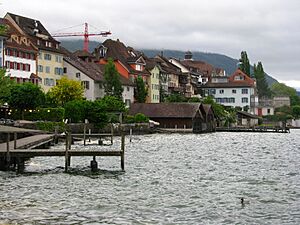
Early Times
People have lived in the Zug area for a very long time. The oldest signs of humans are from about 14,000 BC. These were nomadic hunters.
Archaeologists have also found over 40 ancient villages built on stilts by the shores of Lake Zug. These "pile dwellings" were home to some of the first farmers in the area, between 5,500 and 2,200 BC. One famous village, called Sumpf (the swamp), dates from the late Bronze Age. You can see many of these old finds at the Zug Museum for Prehistory.
How Zug Became a Town
Around AD 600, Alemannic families moved into the area. The first written record about the area is from 858. It mentions King Ludwig the German giving a farm to a convent.
Later, the powerful Habsburg family gained control of the area. They were a major power until about 1400.
The town of Zug itself started to grow after 1200. It likely got its town walls from the counts of Kyburg. The town was first mentioned in 1240. In 1273, Rudolph of Habsburg bought Zug, and it came under Habsburg rule. Zug became an important place for trade and administration.
Joining the Swiss Confederation
In 1352, the town of Zug and the surrounding areas joined the Swiss Confederation. This was a group of states that worked together. However, Zug had to go back under Habsburg rule for a short time.
Around 1364, Zug rejoined the Confederation and became a full member. In 1379, the Holy Roman Emperor said Zug was free from outside rulers. By 1415, the Habsburgs gave up their claims on Zug. This meant Zug could elect its own leaders and manage its own laws.
Zug slowly grew its territory, adding nearby villages. It became like a small confederation itself, with the town and its surrounding areas working together.
Town Growth and Changes
In 1478, a larger town wall was built, making the town six times bigger. At the same time, the late Gothic St. Oswald Church was started. The town's design was very modern for its time.
During the Reformation, Zug stayed Catholic. This made it a border town between Catholic and Protestant areas in Switzerland.
The old political system ended in 1798 when French troops arrived. After many years of changes, modern Switzerland was formed in 1848. Zug got its current structure with eleven local municipalities.
Modern Zug
In the 19th century, Zug was mostly farmland. But then, industries started to grow. Wolfgang Henggeler built a cotton mill in 1834. Later, George Ham Page founded a condensed milk factory in Cham, which later joined with Nestlé. The company Landis+Gyr, founded in 1896, also became very important.
Connecting to the Swiss railway network in 1864 helped Zug grow a lot. By the second half of the 20th century, Zug became a major financial and trading center. This was helped by its closeness to Zürich and its attractive tax policies. Many jobs were created, and the population grew quickly.
Today, Zug is known as a low-tax region and is home to many international companies. It is also called "Crypto Valley" because many companies working with cryptocurrency are based there, like Ethereum and Cardano.
Zug is also known for its local cherry liqueur, called Kirsch.
Geography and Climate
Where Zug is Located
Zug covers an area of about 33.8 square kilometers (13 square miles). About a third of this land is used for farming, and another third is covered by forests. The rest is made up of buildings, roads, and some unproductive land.
The town is located on the shores of Lake Zug. From the lake, you can see the mountains Rigi and Pilatus, and even the snowy peaks of the Bernese Oberland.
Weather in Zug
Zug has a moderate climate. It gets about 1224 millimeters (48 inches) of rain each year, spread over about 136 days. The wettest month is August, and the driest is January.
People and Economy
Population and Languages
As of 31 December 2020, Zug has a population of 30,934 people. About 31.7% of the people living in Zug are from other countries.
Most people in Zug speak German (81.8%). Italian is the second most common language, and Serbo-Croatian is third.
Education and Jobs
Many adults in Zug have completed higher education. The unemployment rate is low, at 2.28%.
Zug has many jobs in different areas. There are jobs in farming, manufacturing, and especially in the service sector, which includes finance and trade.
Zug is known for accepting digital currency for small payments. This is part of its plan to be a center for new technologies.
Sports in Zug
Zug is famous for ice hockey. The town's main team is EV Zug, which plays in the top Swiss league. They play their games at the Bossard Arena, which can hold 7,200 fans. There are also many junior hockey teams.
Other sports teams in Zug include an amateur association football (soccer) team, Zug 94, and a rugby team, Zug Rugby Club. There is also a floorball team, Zug United, and a successful rowing club, See-Club Zug.
Culture and Museums
Town Sights
The older part of Zug is very charming. You can still see some of the old town walls and towers.
The most important old building is the parish church of St. Oswald, built in the late 15th century. The town hall, also from the 15th century, now holds the Historical and Antiquarian Museum.
Higher up the hill, you can find a Capuchin convent. Even higher, there is the newer St. Michael church, built in 1902.
The business area is north of the old town, near the railway station.
Museums and Arts
Zug has three main museums:
- The Museum of Prehistory Zug shows archaeological finds from the area, especially from ancient lake-shore settlements.
- The Burg (Castle) is now a museum about the cultural history of Zug.
- The Kunsthaus (Art Gallery) has interesting art exhibitions.
There are also theaters and cultural centers that host many events.
Zug is surrounded by beautiful nature, including the Zugerberg mountain, the Sihl river, and the Choller nature reserve near Lake Zug.
A famous local treat is the Zuger cherry liqueur cake. Another local specialty is the Zug 'Rötel', a type of fish from the lake.
Important Heritage Sites
Several places in Zug are listed as important Swiss heritage sites. These include old libraries, archaeological sites like the Sumpf settlement, and museums. The town walls and many buildings in the old town are also protected.
Some of the prehistoric settlements by Lake Zug are even part of a UNESCO World Heritage Site.
Education
Zug has a strong education system. After primary school, students can choose between more schooling or vocational training with an apprenticeship. Many young people choose vocational training, which helps them get ready for jobs.
There are also private schools in Zug, like the Montana Institute Zug and the International School of Zug or Lucerne (ISZL).
Higher Education
Zug has two high schools: the Canton High School in Zug town and the Cantonal School in Menzingen.
For higher education, Zug has a University of Teacher Training and a polytechnic for financial services. There are also six technical colleges for subjects like business, computer science, and engineering.
In 2022, the European Institute of Management and Technology (EIMT) was established in Zug. It offers bachelor's, master's, and doctorate degrees.
International Schools
Zug has four international schools. These schools are important for families who move to Zug from other countries, especially for people working at the many international companies.
Transportation
Zug is a key transportation hub.
Buses and Trains
The town has a large bus network run by ZVB Zugerland Verkehrsbetriebe.
The Swiss Federal Railways connect Zug to many cities like Zürich and Lucerne. Zug is also the center of the Zug Stadtbahn, which is a local train network. It has lines connecting to Baar, Cham, and Walchwil.
The Zugerbergbahn is a funicular railway that takes you from the suburb of Schönegg up to the Zugerberg mountain, offering great views.
Roads and Water Travel
The A4 motorway and other main roads connect Zug to the rest of Switzerland.
You can also travel on Lake Zug by boat. Public boats like MS Zug and MS Schwyz offer trips on the lake.
Notable People from Zug
Many interesting people have come from Zug:
- Johannes Brandenberg (1660–1729), a painter.
- Marc Rich (1934–2013), a businessman who founded Glencore.
- Carl Rütti (born 1949), a famous composer.
- Simonetta Sommaruga (born 1960), a politician who became President of the Swiss Confederation.
- Severin Hacker (born 1984), a computer scientist who co-founded Duolingo.
- Max Husmann (1888–1965), a peacemaker and educator.
- Sports Figures
- Georges Stuber (1925–2006), a football (soccer) goalkeeper for Switzerland.
- Patrick Fischer (born 1975), the head coach of the Swiss national ice hockey team.
- Nadia Styger (born 1978), a former World Cup alpine ski racer.
See also
 In Spanish: Zug para niños
In Spanish: Zug para niños





